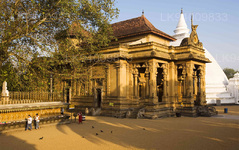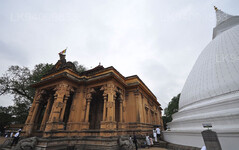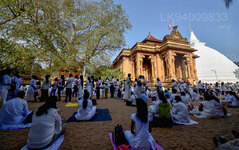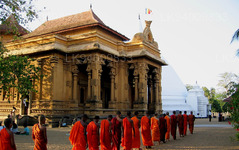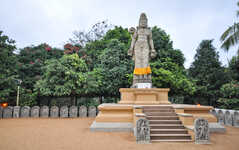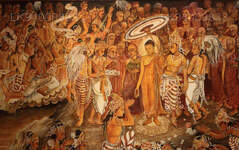
Kelaniya
Kelaniya, a historic town in Sri Lanka, is renowned for the Kelaniya Raja Maha Vihara, an ancient Buddhist temple believed to have been visited by Lord Buddha. Located near Colombo, it features exquisite art and cultural heritage, including vivid murals and a sacred Bodhi tree. Kelaniya is a significant pilgrimage site, celebrated for its annual Duruthu Perahera procession.
Kelaniya Raja Maha Viharaya
The sanctity of the Kelaniya Temple and the site:
Kelaniya Temple built on the banks of the Kelaniya River is one of the most sacred sites of Sri Lanka. It is believed Buddha together with 500 Arahats (Supremely enlightened beings) visited Kelaniya on the Wesek day of the Buddhist Era 2531 and expounding of the Dhamma, the Buddhist doctrine to the inhabitants of the island. Buddha’s timely visit to the island resulted in quelling an imminent war between two kings named Chulodara and Mahodara over a jewel–encrusted throne. Buddha having preached the doctrine on the disputed throne offered to him ensued lasting peace between the two kings. The great stupa built upon the site enshrining the throne was since then called Kelaniya Raja Maha Vihara.History of Kelaniya Temple:
Kelaniya Temple believed to had been built in the era prior to the chronologically recorded history of Sri Lanka (since 543 B.C) was renovated by Prince Uttiya, brother of King Devanampiyatissa following the arrival Arahat Mahinda in 307 BC. According to the Mahawansa, King Devanampiyatissa’s brother Uttiya renovated the vihara for the first time. Prince Uttiya also built the first ever residential quarters of the Buddhist monks (Sanghawasa) there.
The ancient temple was destroyed time and again by the Dravidian invaders from Southern India. Each time the temple had been reconstructed. The medieval temple was destroyed by the Portuguese in 1510 yet reconstructed by King Kirthi Sri Rajasingha in the year 1967. New Temple was initiated in 1927 and completed in 1946 under the patronage of philanthropist Mrs. Helena Wijewardene.
The Bo tree and the court yard at the Kelaniya Temple:
The entrance to the temple yard is over the park across the main street. The arched grill gate opens upto the lower terrace of the temple yard. The lower terrace leads four sets of flight of steps in four carinal directions to the Upper terrace which features the Image Hose, Dagaba and the Bo Tree (Peepal tree) with other buildings.
New Temple:
Aluth Vihara Ge or the New Temple House section of the Kelani Viharaya is 150 feet long and 90 feet broad. It stands on a stone plinth 3 feet in height. The roof is built in the Kandyan architectural style with a design of an octagon.
- ‘Aluth Vihara Ge’ consists of four mage houses.
- The ‘Oth Pilima Ge’, the oldest section of the temple houses a large reclining Buddha statue and two seated Buddha statues.
- The ‘Ran Pilima Ge’ houses another seated Buddha statue.
- The ‘Ran Pilima Ge’ or the Golden Buddha Image House
Murals in Kelaniya Temple:
Kelaniya Temple has none of the ancient or medieval paintings. The murals are those of the 18th century and the early 20th century.
The Duruthu Perahera (Kelani Procession):
Kelaniya Temple is the starting point of the “The Duruthu Perahera” (Kelani Procession) inaugurated in 1927 and since then that has been held on the pre – full moon day of the month of January every year. Each year hundreds of thousands of locals and thousands of foreign tourists gather at Kelaniya to enjoy the grand procession that features whip crackers, torch carriers, flag carriers, caparisoned elephants, dancers, trumpeters, drummers and numerous other participants. The Kelani Procession features three separate processions: that of the Buddha Relics and those of the three shrines dedicated to the deities of Vishnu, Kataragama and Vibishana. “The Duruthu Perahera” (Kelani Procession) attracts hundreds and thousands of people from all provinces of Sri Lanka, and hundreds of foreign tourists trek their way to the temple purlieu to witness this spectacular pageant.
Murals in Kelaniya Temple
The Kandyan Era Murals: The Kandyan era paintings still in conditions are housed in two chambers. These Paintings illustrates the Jataka Stories that had been created to inspire virtues of compassion. On the wall are also displayed a literary depiction of Buddha’s battle against the defiling factors.
Modern Murals on the walls: The beautiful modern paintings done by Soliyas Mendis during 1927-1946 illustrates the major events of the history of Buddhism in Sri Lanka. Among the panels of paintings are King Devanmpiyatissa donating the Mahamegha park to Arahat Mahinda; the congregation of monks inscribing Tripitaka, the Buddhist doctrine; Indian scholar monk presenting Visuddhimagga, the commentaries on the Buddhist doctrine, to the Sangharaja of Maha Vihara; the arrival of Buddhist nun Theri Sangamitta; arrival of Prince Danta and Princess Hemamala from Northern India with the Sacred Tooth Relic.
Modern Murals on the ceiling: On the ceiling are depicted the planetary gods or the navagrahayo, the nine planets of the oriental astrology and the twelve zodiacal signs or the Rashis.

